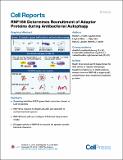| dc.contributor.author | Heath, Robert J. | |
| dc.contributor.author | Goel, Gautam | |
| dc.contributor.author | Baxt, Leigh A. | |
| dc.contributor.author | Rush, Jason S. | |
| dc.contributor.author | Mohanan, Vishnu | |
| dc.contributor.author | Paulus, Geraldine L.C. | |
| dc.contributor.author | Jani, Vijay | |
| dc.contributor.author | Lassen, Kara G. | |
| dc.contributor.author | Xavier, Ramnik Joseph | |
| dc.date.accessioned | 2017-04-14T20:36:26Z | |
| dc.date.available | 2017-04-14T20:36:26Z | |
| dc.date.issued | 2016-11 | |
| dc.date.submitted | 2016-10 | |
| dc.identifier.issn | 2211-1247 | |
| dc.identifier.uri | http://hdl.handle.net/1721.1/108191 | |
| dc.description.abstract | Xenophagy is a form of selective autophagy that involves the targeting and elimination of intracellular pathogens through several recognition, recruitment, and ubiquitination events. E3 ubiquitin ligases control substrate selectivity in the ubiquitination cascade; however, systematic approaches to map the role of E3 ligases in antibacterial autophagy have been lacking. We screened more than 600 putative human E3 ligases, identifying E3 ligases that are required for adaptor protein recruitment and LC3-bacteria colocalization, critical steps in antibacterial autophagy. An unbiased informatics approach pinpointed RNF166 as a key gene that interacts with the autophagy network and controls the recruitment of ubiquitin as well as the autophagy adaptors p62 and NDP52 to bacteria. Mechanistic studies demonstrated that RNF166 catalyzes K29- and K33-linked polyubiquitination of p62 at residues K91 and K189. Thus, our study expands the catalog of E3 ligases that mediate antibacterial autophagy and identifies a critical role for RNF166 in this process. | en_US |
| dc.description.sponsorship | Leona M. and Harry B. Helmsley Charitable Trust (2014PG-IBD016) | en_US |
| dc.description.sponsorship | National Institutes of Health (U.S.) (R01DK097485) | en_US |
| dc.description.sponsorship | National Institutes of Health (U.S.) (U19AI109725) | en_US |
| dc.description.sponsorship | National Institutes of Health (U.S.) (P30DK043351) | en_US |
| dc.language.iso | en_US | |
| dc.publisher | Elsevier | en_US |
| dc.relation.isversionof | http://dx.doi.org/10.1016/j.celrep.2016.11.005 | en_US |
| dc.rights | Creative Commons Attribution-NonCommercial-NoDerivs License | en_US |
| dc.rights.uri | http://creativecommons.org/licenses/by-nc-nd/4.0/ | en_US |
| dc.source | Elsevier | en_US |
| dc.title | RNF166 Determines Recruitment of Adaptor Proteins during Antibacterial Autophagy | en_US |
| dc.type | Article | en_US |
| dc.identifier.citation | Heath, Robert J. et al. “RNF166 Determines Recruitment of Adaptor Proteins during Antibacterial Autophagy.” Cell Reports 17.9 (2016): 2183–2194. | en_US |
| dc.contributor.department | Institute for Medical Engineering and Science | en_US |
| dc.contributor.mitauthor | Xavier, Ramnik Joseph | |
| dc.relation.journal | Cell Reports | en_US |
| dc.eprint.version | Final published version | en_US |
| dc.type.uri | http://purl.org/eprint/type/JournalArticle | en_US |
| eprint.status | http://purl.org/eprint/status/PeerReviewed | en_US |
| dspace.orderedauthors | Heath, Robert J.; Goel, Gautam; Baxt, Leigh A.; Rush, Jason S.; Mohanan, Vishnu; Paulus, Geraldine L.C.; Jani, Vijay; Lassen, Kara G.; Xavier, Ramnik J. | en_US |
| dspace.embargo.terms | N | en_US |
| mit.license | PUBLISHER_CC | en_US |
| mit.metadata.status | Complete | |
